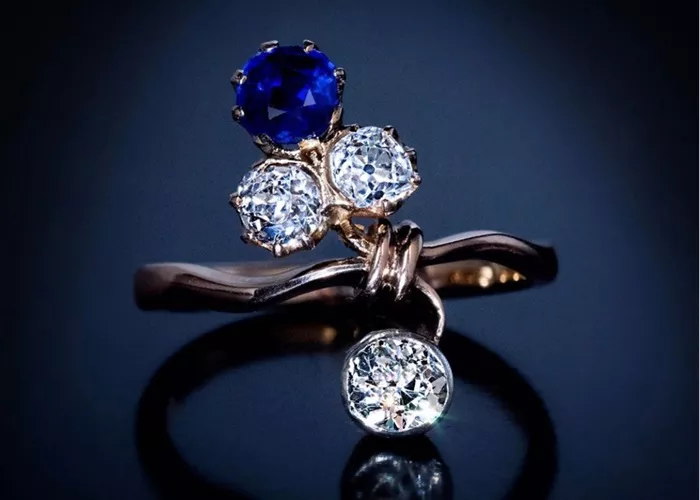Blue sapphires are among the most coveted gemstones in the world, prized for their stunning hues and timeless elegance. However, not all blue sapphires are created equal. The color of a blue sapphire plays a significant role in determining its value. In this article, we will explore what makes a blue sapphire expensive, focusing on the most sought-after colors and the factors that influence their pricing.
The Importance of Color in Blue Sapphires
Understanding the Color Spectrum
Blue sapphires belong to the corundum family of minerals, and their color ranges from pale blue to deep, vivid shades. The most valuable blue sapphires exhibit a rich, velvety blue hue with a slight violet undertone. This specific shade is often referred to as “cornflower blue” or “Kashmir blue,” named after the legendary sapphires from the Kashmir region.
The Role of Hue, Tone, and Saturation
When evaluating a blue sapphire’s color, gemologists consider three key factors:
Hue: The primary color of the stone. In blue sapphires, the ideal hue is pure blue, though slight secondary hues like violet or green can be present.
Tone: The lightness or darkness of the color. The most desirable tone is medium to medium-dark.
Saturation: The intensity of the color. High saturation gives the stone a vivid, vibrant appearance.
The combination of these factors determines the overall beauty and value of the sapphire.
The Most Expensive Blue Sapphire Color
Kashmir Blue: The Gold Standard
The most expensive blue sapphires are those with the iconic “Kashmir blue” color. These stones are renowned for their velvety texture and intense, saturated blue hue with a subtle violet undertone. The Kashmir region in India was the primary source of these exceptional sapphires in the late 19th and early 20th centuries. Today, Kashmir sapphires are extremely rare, and their unmatched color commands premium prices at auctions and in the market.
Ceylon Blue: A Close Contender
Sapphires from Sri Lanka, often referred to as Ceylon sapphires, are also highly valued. They typically exhibit a lighter, brighter blue color compared to Kashmir sapphires. While they may lack the velvety texture of Kashmir stones, top-quality Ceylon sapphires with high clarity and saturation can still fetch significant prices.
Burmese Blue: Rich and Royal
Blue sapphires from Myanmar (Burma) are known for their deep, royal blue color. These stones often have a slightly darker tone than Kashmir sapphires, but their rich color and excellent clarity make them highly desirable. Burmese sapphires are also rare, adding to their value.
Factors That Influence the Price of Blue Sapphires
Origin Matters
The origin of a blue sapphire significantly impacts its value. Kashmir sapphires are the most expensive due to their rarity and unique color. Burmese and Ceylon sapphires follow closely, with their own distinct characteristics. Sapphires from other locations, such as Madagascar or Australia, are generally less expensive but can still be beautiful.
Clarity and Transparency
High-quality blue sapphires should have excellent clarity, meaning they are free from visible inclusions. However, some inclusions, such as silk, can enhance the stone’s appearance by giving it a velvety texture. Stones with poor clarity or visible flaws are less valuable.
Cut and Carat Weight
The cut of a sapphire affects its brilliance and overall appeal. Well-cut stones maximize the color and light reflection, enhancing their beauty. Additionally, larger sapphires are rarer and more valuable, especially if they exhibit top-quality color and clarity.
Treatments and Enhancements
Natural, untreated blue sapphires are the most valuable. However, many sapphires on the market undergo heat treatment to improve their color and clarity. While this is a common practice, untreated stones are always more prized and command higher prices.
How to Identify a High-Quality Blue Sapphire
Look for the Ideal Color
When shopping for a blue sapphire, prioritize stones with a rich, saturated blue hue. Avoid stones that appear too light or too dark, as these are less valuable.
Check for Clarity
Examine the stone under magnification to assess its clarity. Look for stones with minimal inclusions and excellent transparency.
Verify the Origin
If possible, ask for a gemological certificate that confirms the sapphire’s origin. Kashmir, Burmese, and Ceylon sapphires are the most desirable.
Consider the Cut and Size
Choose a sapphire with a well-proportioned cut that enhances its color and brilliance. Larger stones are more valuable, but ensure the quality justifies the price.
Conclusion
The color of a blue sapphire is the most critical factor in determining its value. The velvety “Kashmir blue” is the most expensive and sought-after shade, followed by the rich hues of Burmese and Ceylon sapphires. When purchasing a blue sapphire, consider its color, clarity, origin, cut, and carat weight to ensure you are getting a high-quality stone. Whether you are a collector or a jewelry enthusiast, understanding these factors will help you appreciate the beauty and value of blue sapphires.
Related topics:
- Why Your Blue Sapphire Ring May Look Black?
- Is a Sapphire More Expensive Than a Diamond?
- What Does a Rough Sapphire Look Like?


